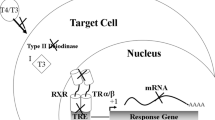Abstract
Background and aims: Previous studies have shown that blood concentrations of free thyroxin and basal thyroid-stimulating hormone (TSH) decrease during adult life. Suggested mechanisms include reduced thyroid activity resulting from decreased serum TSH concentrations, impairment of peripheral 5′-deiodinase, and an increase in reverse 3,5,3′-triiodothyronine due to non-thyroidal illness. However, testing of pituitary reserves leads to contradictory results and has infrequently been evaluated in studies. Methods: We investigated whether the response of TSH to thyrotropin-releasing hormone (TRH) is preserved during aging. This was tested in a cohort of 387 subjects aged 13 to 100 years in whom thyroid disease was excluded by normal thyroid ultrasound, normal values for free thyroxin, free triiodothyronin, TSH, and negative thyroid peroxidase antibodies. Results: Serum concentrations of free thyroxin remained almost unchanged, whereas free triiodothyronin and TSH levels were lower in older subjects. In addition, the TSH response to TRH was blunted in older subjects, especially in male individuals. Conclusions: There is evidence that the decreased thyroid hormone levels observed in aging are due to lower TSH concentrations, and that lower TSH concentrations may be linked to an impaired pituitary activity.
Similar content being viewed by others
References
Levy EG. Thyroid disease in the elderly. Med Clin North Am 1991; 75: 151–67.
Harman SM, Wehmann RE, Blackman MR. Pituitary-thyroid hormone economy in healthy aging men: basal indices of thyroid function and thyrotropin responses to constant infusions of thyrotropin releasing hormone. J Clin Endocrinol Metab 1984; 58: 320–6.
Snyder PJ, Utiger RD. Response to thyrotropin releasing hormone (TRH) in normal man. J Clin Endocrinol Metab 1972; 34: 380–5.
Erfurth EM, Norden NE, Hedner P, Nilsson A, Ek L. Normal reference interval for thyrotropin response to thyroliberin: dependence on age. sex. free thyroxine index and basal concentrations of thyrotropin. Clin Chem 1984; 30: 196–9.
van Coevorden A, Laurent E, Decoster C, et al. Decreased basal and stimulated thyrotropin secretion in healthy elderly men. J Clin Endocrinol Metab 1989; 69: 177–85.
Mariotti S, Barbesino G, Caturegli P, et al. Complex alteration of thyroid function in healthy centenarians. J Clin Endocrinol Metab 1993; 77: 1130–4.
Magri F, Muzzoni B, Cravello L, et al. Thyroid function in physiological aging and in centenarians: possible relationships with some nutritional markers. Metabolism 2002; 51: 105–9.
Ohara H, Kobayashi T, Shiraishi M, Wada T. Thyroid function of the aged as viewed from the pituitary-thyroid system. Endocrinol Jpn 1974; 21: 377.
Mariotti S. Thyroid function and aging: do serum 3,5,3′- triiodothyronine and thyroid-stimulating hormone concentrations give the Janus response? J Clin Endocrinol Metab 2005; 90: 6735–7 (Editorial).
Silva JE, Larsen PR. Comparison of iodothyronine 5′-deiodinase and other thyroid hormone-dependent enzyme activities in the cerebral cortex of hypothyroid neonatal rat. Evidence for adaptation to hypothyroidism. J Clin Invest 1982; 70: 1110–23.
Visser TJ, Kaplan MM, Leonard JL, Larsen PR. Evidence for two pathways of iodothyronine 5′-deiodination in rat pituitary that differ in kinetics, propylthiouracil sensitivity, and response to hypothyroidism. J Clin Invest 1983; 71: 992–1002.
Christoffolete MA, Ribeiro R, Singru P, et al. Atypical expression of type 2 iodothyronine deiodinase in thyrotrophs explains the thyroxine-mediated pituitary TSH feedback mechanism. Endocrinology 2006; 147: 1735–43.
Author information
Authors and Affiliations
Corresponding author
Rights and permissions
About this article
Cite this article
Sell, M.A., Schott, M., Tharandt, L. et al. Functional central hypothyroidism in the elderly. Aging Clin Exp Res 20, 207–210 (2008). https://doi.org/10.1007/BF03324770
Received:
Accepted:
Published:
Issue Date:
DOI: https://doi.org/10.1007/BF03324770




